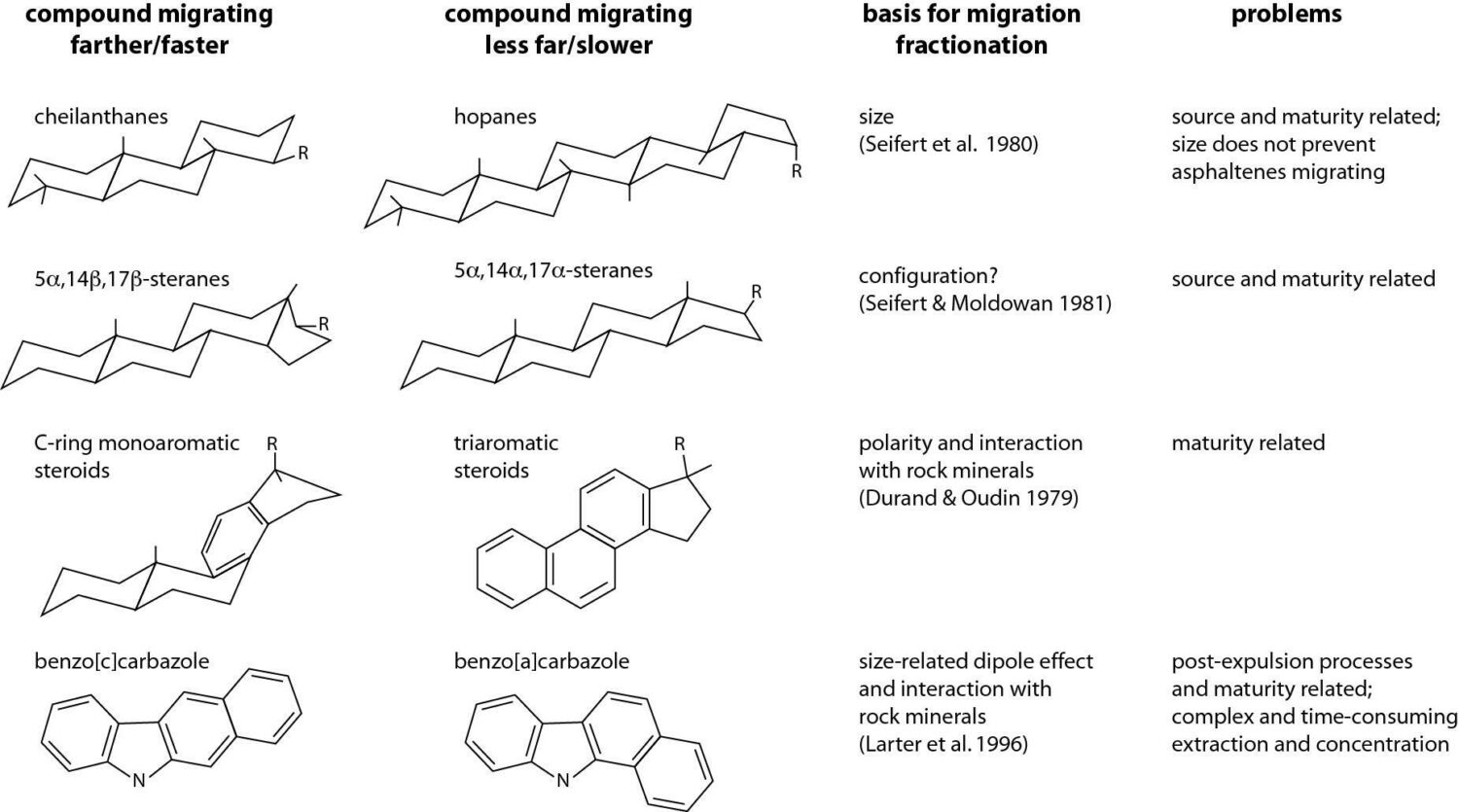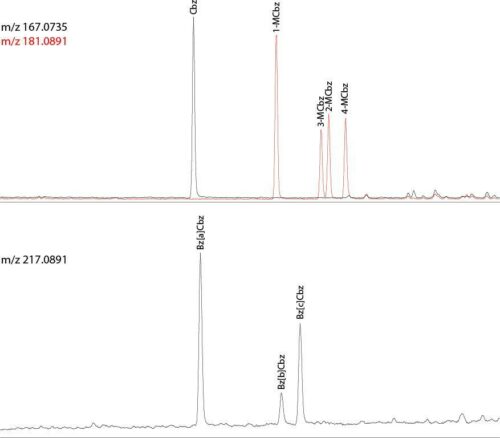Secondary migration distances
Applications
It is likely that the rate of migration of individual compounds from source to reservoir is affected by pinch-points (pore throat sizes and resulting tortuosity) and interaction with mineral surfaces (at least until the migration route is coated with an oil phase). Relative distances from a particular kitchen may be obtained from GC-MS analysis of some pairs of compounds.

GC-MS analysis of pairs of compounds to examine distance from the source kitchen
All ratios are affected to an extent by processes other than migration. The most reliable may be the benzocarbazole ratio, which has been used to estimate actual migration distances, although its success has been found to be variable (e.g. Li et al. 1997; Li et al. 1998; Bennett et al. 2002).
The ratio of benzo[a]carbazole to benzo[c]carbazole is proposed to decrease with migration distance (Larter et al. 1996). The absolute concentration of benzocarbazoles also tends to decrease with increasing migration distance, consequently, a cross plot of the benzocarbazole isomer ratio against the normalized concentration of total benzocarbazoles (i.e. normalised to the highest concentration observed in the set of oils) can be used, with both parameters tending to decrease with increasing migration distance.
The best results are likely to be obtained from low throughput carrier systems, comprising small reservoirs charged via comparatively long migration pathways (i.e. ratio of volume of carrier rock to volume of reservoired oil is large).
In contrast, in prolific basins, where large volumes of oil have passed through the same carrier network, little net tracer fractionation will be seen in the final reservoired oil.
Unlike the other ratios, which can be evaluated from routine GC-MS-SIR data from saturates and aromatics fractions, the benzocarbazole data requires a dedicated analysis.
Sample requirements
Oils or reservoir extracts (core plugs are best). Plugging should be performed using additive-free water. Organic based lubricants must be avoided, as should proximity to other plugs sites (e.g. for poroperm determination) and the periphery of cores and areas containing fractures.
A minimum of 5 g of core is required for the analysis.
Analytical procedure

Oils/extracts are subjected to MPLC to isolate a polars fraction. The GC-MS analysis to determine carbazoles and benzocarbazoles is performed on a DFS high resolution instrument. The instrument is tuned to a resolution of 3000 and data is acquired in SIR mode.
A 60 m x 0.25 mm i.d. CP-Sil-8 CB-MS column (film thickness 0.25 mm) is used, with a temperature programme of 50°C (1 min.) to 180°C at 20°/min., then to 270 °C at 2°/min., and finally to 300°C (20 min.) at 20°/min. D8-carbazole is used as internal standard when quantitative results are requested.
Potential problems
- Absence/very low abundance of carbazoles in general
- Factors such as migration route saturation and multiple charges of varying composition may negate results
References
Bennett B., Chen M., Brincat D., Gelin F.J.P., Larter S.R. (2002) Fractionation of benzocarbazoles between source rocks and petroleums. Organic Geochemistry 33, 545–559.
Durand B., Oudin J.L. (1979) Exemple de migration des hydrocarbures dans une série deltaique: le delta de la Mahakam, Kalimantan, Indonésie. Proceedings 10th World Petroleum Congress 2, 3–11.
Larter S.R., Bowler B.F.J., Li M., Chen M., Brincat D., Bennett B., Noke K., Donohoe P., Simmons D., Kohnen M., Allan J., Telnaes N., Horstad I. (1996) Molecular indicators of secondary oil migration distances. Nature 383, 593–597.
Li M., Yao H., Stasiuk L.D., Fowler M.G., Larter S.R. (1997) Effect of maturity and petroleum expulsion on pyrrolic nitrogen compound yields and distributions in Duvernay Formation petroleum source rocks in central Alberta, Canada. Organic Geochemistry 26, 731–744.
Li M., Yao H., Fowler M.G., Stasiuk L.D. (1998) Geochemical constraints on models for secondary petroleum migration along the Upper Devonian Rimbey-Meadowbrook reef trend in central Alberta, Canada. Organic Geochemistry 29, 163–182.
Seifert W.K., Moldowan J.M. (1981) Paleoreconstruction by biological markers. Geochimica et Cosmochimica Acta 45, 783–794.
Seifert W.K., Moldowan J.M., Jones R.W. (1980) Application of biological marker chemistry to petroleum exploration. Proceedings 10th World Petroleum Congress, Bucharest 1979, 425–438. Heyden & Son Ltd, London.